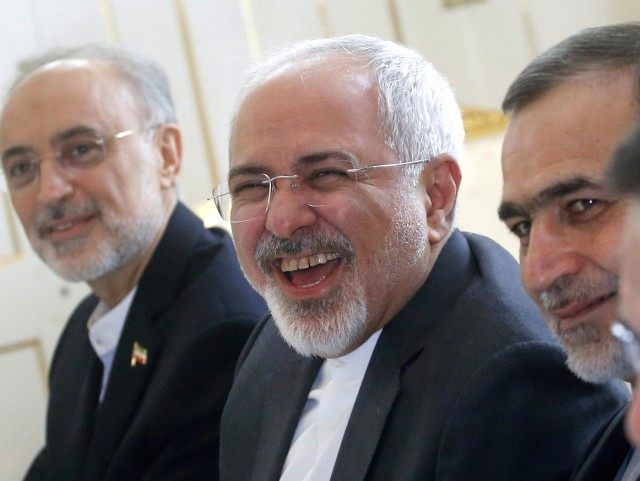Iran is adopting Donald Trump’s Art of the Deal strategy by scrambling to sign Western energy deals as bargaining chips before confronting the President-elect, who once called the Iran nuclear deal “one of the worst deals ever made by any country in history.”
A major target of Donald Trump’s campaign for president was blaming the Obama administration for securing too little in return from the negotiations with Iran to end the crippling U.N. economic sanctions. Trump complained, “Thanks to Hillary Clinton, Iran is now the dominant Islamic power in the Middle East, and on the road to nuclear weapons.”
The ironic advantage of suffering from a decade of crippling economic sanctions is that by early 2015, Iran was forced to restructure its government spending to the point that the nation can survive on $25 a barrel oil, according to Iran’s Oil Minister Bijan Zanganeh.
That is in stark contrast to recent warnings by Geopolitical Futures’ George Friedman that if Iran’s main Middle East rival, Saudi Arabia, is unable to keep the price of oil up to at least $90 a barrel to fund the lavish entitlement spending that maintains the kingdom’s legitimacy, “Riyadh’s unique social stability comes apart.”
Breitbart reported in ‘Iran Sanctions Relief Will Break Russia’s Gas Monopoly,’ that one European motive for lifting sanctions on Iran was a Western effort to tap Iran’s massive natural gas reserves with the latest technology in order to undermine the continent’s overwhelming dependence on Russia to supply natural gas for industrial and home heating purposes.
According to the EU Council on Foreign Relations, Russia’s dominance in supplying Europe with natural gas makes about one third of Europe “insecure” (more than 80 percent of its total annual consumption), while another third are only “secure” (should be able to find expensive alternatives) from a political disruption of Russian natural gas imports.
With 1,200 trillion cubic feet of gas and the fastest growing natural gas reserves, Iran now has the second-largest gas reserves on the planet, with about 70 percent of Russia’s reserves and three times U.S reserves. Such a vast supply of natural gas coming onto markets would drastically undermine Russia’s energy dominance of Eastern Europe.
Prior to the most restrictive sanctions, Iran was producing little natural gas for export and only about 4.1 million barrels of oil per day (mb/d), with about 600,000 mb/d exported to Europe. Oil production tumbled with the 2012 sanctions to an average of 2.7 mb/d. Official post-sanctions Iranian oil production is 3.9 mb/d, but the real number is about $4.3 mb/d.
The reason for the Iran production spike, which could soon reach a capacity of over 6 mb/d, is that nation’s approval of a new foreign investment agreement. Iran, pre-sanctions, only offered five-year drilling contracts to foreign oil companies that mandated all crude be sold to the government at steep discounts to world markets, so the Iran could sell domestic refined gasoline at $1.16-per-gallon — about a 50 percent world price discount.
But in an effort to recruit $100 billion in foreign capital, Iran’s post-sanctions “new model” offers 25-year joint-venture oil and gas production contracts on favorable terms to foreign companies, including letting Iran’s domestic price of gasoline float to $1.51 per gallon. The contract terms are designed to be much more favorable than in Saudi Arabia.
With Shiite Iran’s foreign investment flooding in, and its cash flow spiking up, as Sunni Saudi Arabia spirals into economic chaos, and Iran’s Syrian ally Bashar al-Assad “liberating” the last rebel neighborhoods in Aleppo, presidential candidate Trump now seems visionary when he said, “Iran is now the dominant Islamic power in the Middle East.”
Consistent with one point in Trump’s Art of the Deal — “2) Protect the Downside and Upside will take Care of Itself” — Iran has inked energy development deals over the last month with China, Norway, Poland, Thailand, Royal Dutch Shell, and U.S. based Schlumberger in an effort to cement its “normalization” of international relationships before having to negotiate with President Trump beginning on January 20.
President-elect Trump appears to be preparing for Iranian negotiations by using the Art of the Deal strategy to “8) Fight back”, “9) Deliver the goods”, and “11) Have fun” by leaking the name of Exxon Chairman and CEO Rex Tillerson as a prime candidate for the next U.S. Secretary of State.
As Trump famously said, “What separates the winners from the losers is how a person reacts to each new twist of fate.”

COMMENTS
Please let us know if you're having issues with commenting.